How to Play Shatranj
The Chess of the Ancient World
Download
a free rule booklet ------
Shop
for a playing set

The form of chess we play today is just over 500 years old. And our conventional design of chess pieces, the Staunton style, has only been around for about a century and a half. But before our modern chess spread across Europe, there was an older form of chess, lasting for almost 1000 years, with its own rules and with its own conventional playing pieces. This older form existed in Persia before the 7th century Muslim conquest. It then spread across the expanding Arab world, through northern Africa, and throughout Europe — all the while maintaining the same set of rules and the same style of chessmen. Although some minor variations did occur, the basic game remained the same, lasting centuries and spanning continents. The conventional shapes of the ancient chess pieces are rather mysterious. Generally speaking, they are simplified abstractions based on familiar carvings of the pieces they represent: The King (on elephant back), his Counselor (also riding an elephant) an Elephant warrior (the tusks are apparent), a Horse (the protruding nose identifies this piece), a Chariot (a V-shaped groove somehow indicates a chariot). The rules given here are the best available account of how the game of chess (Persian chatrang; Arabic shatranj) was played in Persia, probably as long ago as the 6th century A.D. |
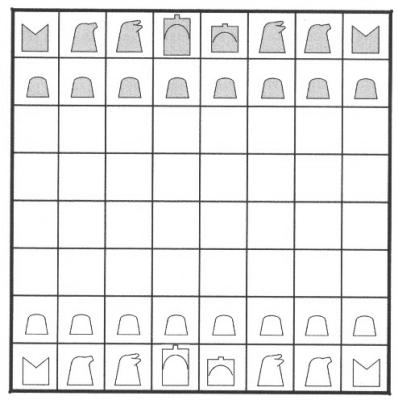
The pieces are set up, as shown above, much as they are in our modern chess. The White side has his King (the larger piece) on the left, and the Black side has the King on his right, so that the two face each other. As in modern chess, each piece has a characteristic move — and many of these moves are familiar to a modern chess player. The King, for instance, moves one square in any direction. He has no power of castling. |
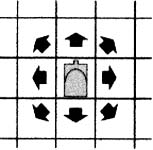 |
|
| The Chariot (which retains its ancient Persian name in English as “Rook”) moves as many squares as it wishes, forward, backward, left or right, until it reaches another piece, or the end of the board. Exactly like the modern Rook. |  |
|
The Horse (Knight) moves in a peculiar L-shape: two spaces forward, backward, right or left, plus one square at a right angle. It can not be blocked by another piece. This move also is exactly like its modern counterpart. |
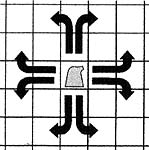 |
|
| The Foot Soldier’s move is similar to that of the modern pawn. It moves one square forward when not capturing, but captures by moving one square forward/diagonally (shown by X's in the diagram). Unlike the modern pawn, this soldier had no option of moving two squares on its first move. When it reaches the far end of the board it promotes, but only to a Counselor — a rather weak piece. |
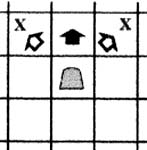 |
|
The Couselor (which became the Queen of modern chess) moves only one square diagonally. |
 |
|
| The Elephant (which became our modern Bishop) has the peculiar move of exactly two spaces diagonally. A move which allows it to reach only eight squares on the entire board. Like the Horse, the Elephant can jump over any piece that stands in its way. Just why an elephant is associated with this leaping, diagonal move is an interesting mystery. | 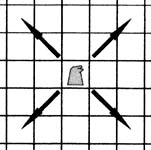 |
All
pieces capture by landing on the square of an opposing piece,
and removing that piece from the board. Only the pawn has a special
move for capturing. All others capture just as they move normally.
If a player’s King is threatened with capture, “check” (Persian: “Shah”) is declared, and the player must move so that his King is no longer threatened. If there is no possible move to relieve the King of the threat, he is in “checkmate” (Persian: “shahmat,” meaning, “the king is at a loss”), and the game is over. Even if the King is not under immediate threat, but any possible move would subject him to capture (stalemate), he has lost the game. Also, if one side is reduced to a king alone with no other men, he loses as a “bare king,” unless he can reduce the other player to a bare king on the very next move, in which case the game is a draw. Finally, if it can be demonstrated that neither side has enough power on the board to force a win by checkmate, stalemate or bare king, the game is drawn. |
Download a free rule booklet ------ Shop for a playing set
HOME
PAGE CHESS PRODUCTS: International | Asian | Reproductions | Unique | Rare | Other Games CHESS HISTORY PAGES: 1 | 2 | 3 | 4 | 5 | 6 | 7 | 8 | 9 | 10 HOW TO PLAY: Chess | Courier Chess | Sittuyin | Xiangqi | Shogi | Shatranj | Janggi Makruk | Shatar | Dou Shou Qi | Luzhanqi LINKS: Chess Variants | Chess History | Chess Articles | Mah Jongg AFFILIATED SITES: Rick Knowlton | Courier Chess | Knowlton Mosaics Ken Knowlton | Insite Age | VerySpecial.us CONTACT US |